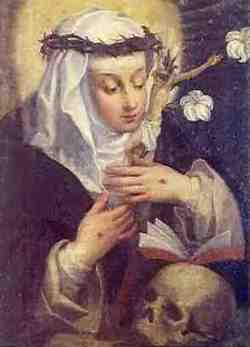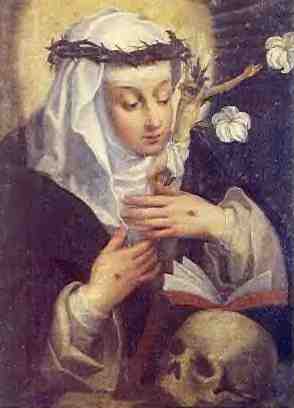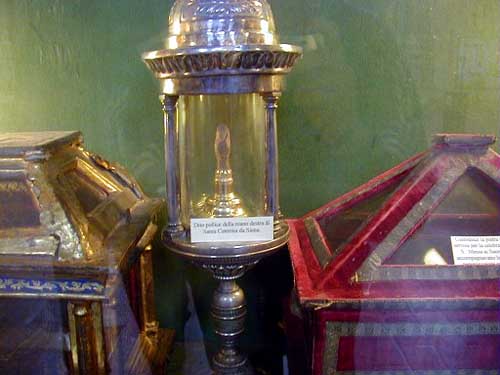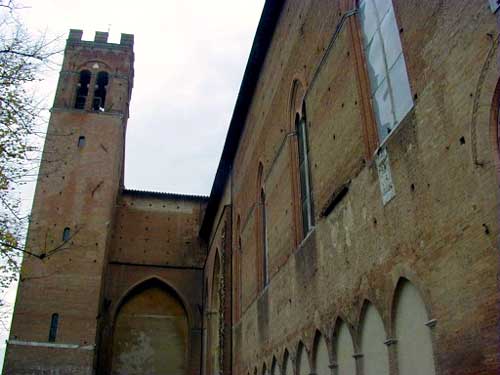In 1363, she took her vows as a Sisters of Penance of St. Dominic. For her first three years, she remained isolated in her room, seeing only her confessor. Uneducated and illiterate, she nevertheless threw herself into her mission, becoming active in the public and political world. She dictated letters and other works to secretaries; the best known of these is "Dialogo," a series of theological treatises on church doctrine. She frequently fasted and practiced self-scourging.
In June 1376, she went to Avignon as an ambassador, and had private audiences with Pope Gregory XI. Rome promised to submit to papal authority if the Pope returned, so, on January 17, 1377, Gregory XI did so. Catherine is one of those credited with persuading him to return to Rome. Upon the death of Gregory XI, however, the return to Rome led to the Great Schism and the subsequent election of two popes. Catherine threw herself behind the Roman elected Pope, Urban VI, and was highly critical of those who supported the so-called Anti-Pope in Avignon, Clement VII.
She traveled widely, both advocating the internal reform of the Church and to encourage peace among the Italian states. In 1380, following an extreme fast, she fell seriously ill. She suffered what appeared to be a paralytic stroke, and within a week had died.
Pope Pius II beatified her on December 29, 1460, and canonized her on June 29, 1461. In 1939, she and St. Francis of Assisi were declared co-patrons of Italy. On October 4, 1970, Pope Paul VI named her a Doctor of the Church, a title indicating that she is recognized as having made a significant contribution to theology or doctrine through her research, study, or writing.She was the second woman to be so named. In 1999, Pope John Paul II proclaimed her a co-patron saint of Europe. In art, she is usually depicted in a Dominican habit, and often with lilies. She is also known as Caterina di Jacopo di Benincasa. Her feast day is celebrated on April 29.
In 1363, she took her vows as a Sisters of Penance of St. Dominic. For her first three years, she remained isolated in her room, seeing only her confessor. Uneducated and illiterate, she nevertheless threw herself into her mission, becoming active in the public and political world. She dictated letters and other works to secretaries; the best known of these is "Dialogo," a series of theological treatises on church doctrine. She frequently fasted and practiced self-scourging.
In June 1376, she went to Avignon as an ambassador, and had private audiences with Pope Gregory XI. Rome promised to submit to papal authority if the Pope returned, so, on January 17, 1377, Gregory XI did so. Catherine is one of those credited with persuading him to return to Rome. Upon the death of Gregory XI, however, the return to Rome led to the Great Schism and the subsequent election of two popes. Catherine threw herself behind the Roman elected Pope, Urban VI, and was highly critical of those who supported the so-called Anti-Pope in Avignon, Clement VII.
She traveled widely, both advocating the internal reform of the Church and to encourage peace among the Italian states. In 1380, following an extreme fast, she fell seriously ill. She suffered what appeared to be a paralytic stroke, and within a week had died.
Pope Pius II beatified her on December 29, 1460, and canonized her on June 29, 1461. In 1939, she and St. Francis of Assisi were declared co-patrons of Italy. On October 4, 1970, Pope Paul VI named her a Doctor of the Church, a title indicating that she is recognized as having made a significant contribution to theology or doctrine through her research, study, or writing.She was the second woman to be so named. In 1999, Pope John Paul II proclaimed her a co-patron saint of Europe. In art, she is usually depicted in a Dominican habit, and often with lilies. She is also known as Caterina di Jacopo di Benincasa. Her feast day is celebrated on April 29.
Bio by: Iola
Advertisement
See more Catherine of Siena memorials in:
Explore more
Sponsored by Ancestry
Advertisement






